Тематическим заданием конкурса были задачи-миниатюры с не менее чем
двумя сказочными условиями. На конкурс поступило 70 задач от 25 авторов из
Украины, Венгрии, Германии, Румынии, Франции, Польши, Азербайджана,
Испании, Норвегии, Израиля, Словакии. При присуждении в отдельный раздел
были выделены задачи-малютки.
Раздел миниатюр / Miniatures
|
R.J.Millour
1st Prize |
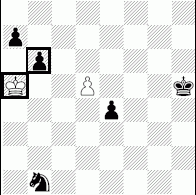
|
|
a)Where was Bc8 captured?
/ Где был взят Bc8 ?
b) In what order were the Knights captured? / В каком порядке были взяты кони? c) Can 2 pieces have been captured on d2-square of the same board? / Возможно, что 2 фигуры были взяты на поле d2 одной и той же доски? Monochrome chess Alice chess A(1+4) B(1+1) |
|
In what follows, the pieces appearing in square brackets (“[ ]”]
are original ones. So, [Sb1] refers to the WS that was on b1 at
the start of the game, whereas Sb1 is the BS presently on b1.
Boards A/B are referred to as A/B states. The squares where
pieces are captured in B state are underlined. So, c2-
c4:[Pd7]d5 means that WPc, in B state on c4 after a doublestep,
captures BPd, itself in B state on d5 after a double-step.
In Monochrome Alice, 0-0-0 is forbidden and a K appearing in A
state on the a-c-e-g files, or in B state on the b-d-f-h files,
cannot have played 0-0. On the other hand, a K appearing in B
state on the a-c-e-g files, or in A state on the b-d-f-h files, must
have castled. Here, White and Black played 0-0!
Consider Pawns. Getting a BP to 5th rank in A state excludes
the possibility of a double-step and implies 2 captures, in B
state on 4th rank 3 captures, etc., and promoting a P requires 4
or 6 captures depending on whether it began with a doublestep.
A pawn can capture an opponent pawn only if they both
are in the same state right before the capture; in view of that, a
P beginning with a double-step may capture an opponent P
itself using the double-step, but may neither capture e.p. nor
capture at home an opponent P. Conversely, a P that does not
use the double-step may not capture an opponent P using it,
but may capture e.p. and also capture at home an opponent P.
In Monochrome, the Knights never move; therefore, Sb1 is
promoted. The fact that this S is in A state implies in Alice a 6-
move excelsior, which in Monochrome must be 6 captures one
of which may include an e.p. capture. This excelsior ends with
b3:a/c2:b1=S.
- The piece captured in A state on a/c2 is possibly a WP having never moved, in actual fact with f7-f5:[Pe2]e4 and c2-c4:[Pd7]d5, [Pa2] will be taken at home; - the piece captured in B state on b1 cannot be [Sb1], inevitably taken in A state on account of having never moved; therefore, the 6 victims of the excelsior are [Qd1], [Rh1], [Bf1], [Pb2] e.p., [Pa2] and promotion of [Pg2]! When the last move c7:b6+ is retracted, the Ps on a7 and c7 show that the promotion to Q or R of a WP was needed to capture [Sb8]. This new excelsior does not involve [Rh8], which is available for capture only after the black 0-0, which is possible only after capturing [Sg8] by promoting [Pg2], which promotion implies first the capture of [Ra8], and in actual fact [Ra8] is just freed by capturing [Sb8]! Thus, the 4 victims of this new excelsior will be [Bf8], [Qd8], [Pe7] and [Pg7]. One P will disappear in B state on 5th rank, but the other one must promote because, as a P, it can neither be taken at home, nor on 6th rank in B state as the opponent P is on 5th rank in A state! Thus, finally we have 4 excelsiors according to the following chronology: 1) Release of [Ra1] → d7-d5 releases [Bc8] and c2-c4 allows B:[Sb1]b1. Also e/g7-e/g5 allows B:[Pd2]d2. Here [Pd2] disappears at home in A state, at the end of the move the capturing B piece turns to B state, so that [Ke1] is not in check. [Bc1] is released and, with b1 and c1 unoccupied, [Ra1] escapes via c1. 2) 1st excelsior → Thanks to [Ra1], e/g7-e/g5:[Pf/h2]f/h4:[Ra1]g3:[Bc1]h2:[Sg1]g1=X is possible. Sooner or later, c4:[Pd7]d5 occurs, and also f7-f5:[Pe2]e4 freeing [Bf1]: with g1 and f1 unoccupied, White may castle and capturing [Rh1] becomes possible. 3) 2nd excelsior → Thanks to X, one can do h/f2-h/f4:[Pg/e7] g/e5:[Pe/g7=X]f6:[Bf8]e7:[Qd8]d/f8=Y and Y:[Sb8]b8, freeing [Ra8]. Also [Pd2] could achieve this excelsior giving Y, but we intentionally consider [Pd2] is captured on d2 [see “1)” above] in connection with the 3rd question asked in this problem. 4) 3rd excelsior → Thanks to [Ra8], g2-g4:[Ph7]h5:[Ra8]g6:[Bc8]h7:[Sg8]g8=Z is possible. With g8 and f8 unoccupied, Black may castle. 5) 4th excelsior → Thanks to Z, b7:[Qd1]a/c6:[Rh1]b5:[Bf1]a/c4:[Pb2e.p.]b3:[Pa2]a2: [Pg2=Z]b1=S can take place. 6) Last moves → The WK or Y captures [Rh8], then Y is itself captured by c7:[Ph/f2=Y]b6+. At point "2)" [Ra1], which in Monochrome cannot access the 2nd rank, is inevitably captured on the 3rd. Consequently, [Bc1] disappears on h2, not on f2 where the capturing P would give check the WK before it played 0-0, which could not yet have occurred since [Sg1] has not yet been captured ! For similar reasons, at point "4)" [Bc8] disappears on h7, not on f7. The chronology shows the Knights disappeared in the following order: 1) [Sb1] 2) [Sg1] 3) [Sb8] 4) [Sg8]. "1)" and "3)" show [Pd2] is possibly captured on d2 in A state. Having castled, and therefore in B state on e1, e3, c3 or c1, the WK is not able to take an A-state piece on d2, but "6)" shows Y may capture [Rh8], why not on d2 and why not in A state! So, at first sight, it seems possible that 2 pieces were captured on d2 in the same state. But mind, please! Now we know the states of all the 25 missing pieces at the moment they disappeared and therefore we can determine whether the number of displacements for a side was odd or even. For that, it is sufficient to examine to number of B pieces (present + captured) for the side: if this number is odd, the number of piece displacements is odd, if it is even, the number of piece displacements is even. Here, with his Ka5 White has 1 unit in B state and 6 units were captured in B state at f/h4, h2, e4, b5, b3 and b1, yielding an odd number of piece displacements. But having castled (= 2 displacements in only 1 move), White played an even number of moves. With his Pb6 Black has 1 unit in B state and 5 units were captured in B state at d5, g/e5, e7, h5 and h7, yielding an even number of piece displacements. But having castled, Black played an odd number of moves. This cannot be! Both sides have made the same number of moves; c7xb6+ shows it is White to play! That means that it is not possible for 2 pieces to have been captured on d2 in the same state. 2 pieces could have been captured on d2: [Pd2] in A state, but [Rh8] inevitably in B state! Finally, the answers are / Итак, ответы: a) [Bc8] was captured on h7! /Вс8 был взят на h7 b) 1) [Sb1] 2) [Sg1] 3) [Sb8] 4) [Sg8] c) 2 pieces could not have been captured on d2 on the same board! / Нет, 2 фигуры не могли быть взяты на поле d2 одной и той же доски. Possible proof game / Доказательная партия: 1.c4→B d5→B 2.Qa4→B Bf5→B 3.Qa6→A Bg6→A 4.e4→B B:[Sb1]b1→B 5.h4→B g5→B 6.h:g5→A Bh6→B 7.g4→B Be3→A 8.Be2→B B:[Pd2]d2→B 9.Bf4→B e5→B 10.Bg3→A f5→B 11.Bh2→B f:e4→A 12.f4→B h5→B 13.Rc1→B Bf5→A 14.Rc3→A Be6→B 15.Ra3→B e:f4→A 16.Rg3→A f:g3→B 17.g:h5→A g:h2→A 18.Bf3→A h:[Sg1]g1=X→B 19.Be2→B Xg7→A 20.0-0→B Bc3→A 21.Rf5→A Be5→B 22.Rb5→B Bf6→A 23.g:f6→B Xe7→B 24.f:e7→A Bh3→A 25.e:d8=Y→B Bg4→B 26.Yb6→A b:a6→B 27.Y:[Sb8]b8→B Rc8→B 28.c:d5→A Rc6→A 29.Bc4→A Re6→B 30.Kf2→A Rg6→A 31.Ke3→B Bf5→A 32.h:g6→B Bh7→B 33.g:[Bc8]h7→A a:b5→A 34.h:[Sg8]g8=Z→B b:c4→B 35.b4→B c:b3e.p.→A 36.Yh2→A b:a2→B 37.Zb3→A 0-0→B 38.Zb1→B a:b1=S→A 39.Kd4→A Rf2→A 40.Kc5→B Rd2→B 41.Yf2→B Kh7→A 42.Y:[Rh8]d2→A Kg6→B 43.Yb4→B Kf5→A 44.Yb6→A Kg4→B 45.Kb4→A Kh5→A 46.Ka5→B c:b6→B+. Масштабный замысел! При очень ограниченном материале проходит четкая хронология 4-х эксцельсиоров и строгий порядок взятий коней. |
|
B.Rothmann
2nd Prize |
J.Golha
3rd Prize |
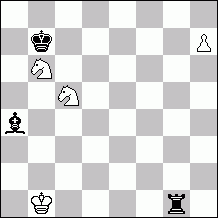
|
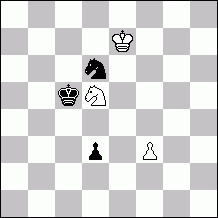
|
|
7# 4+3
|
h4= 3+3
|
|
Marscirce Poursuite 1.Sc4 Kb6 2.Sd3 Kc5 3.Sd2 Kc4 4.Se1 Kd3 5.Sf1 Kd2 6.Sc2+ Ke17.h8Q# Тонкие маневры коней позволяют отключить черные фигуры от узловых полей е1,d1 и сопровождают черного короля к полю е1. |
ParrainCirce EinsteinChess
a)b)Ke7→e6 1.K:d5 Kd7 [+wSc5] 2.Kd4 S:d3=B 3.Ke5 [+bPe4] f:e4=S 4.Kd5 [+bPd4] S:d6=B= 1.Se4=P f:e4=S+ 2.Kc4 [+bPe3] Sd2=P 3.e:d2=S Kd6 [+wPc1] 4.Kd4 c:d2=S= b) 1.Se4=P Ke7 2.K:d5 Ke8 [+wSd6] 3.e:f3=S Kd7 [+wPe2] 4.Sd4=P e:d3=S= Три идеальных патовых финала, два из которых образуют белые кони и удачно дополняющий финал с белыми слонами. |
|
G.Bakcsi & L.Zoltán
4th Prize |
J.Golha
1st Honourable Mention |
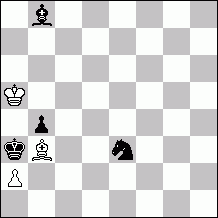
|
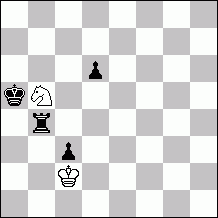
|
|
h15= 3+4
|
h4# 2+4
|
|
MirrorCirce Black must check
1.Sc4+ Kb5 2.Sd6+
Kc5 3.Se4+ Kd4 4.Be5+ Kd3 5.Sf2+ Ke3 6.Bf4+ K:f2 [+bSg1] 7.Bg3+ K:g1 8.Bh2+ Kf2 9.Bg3+ Ke3 10.Bf4+ Kd4 11.Be5+ Ke3 12.Bd4+ Kd2 13.Bc3+ Kc1 14.Bb2+ Kd2 15.Bc1 K:c1= Красиво выполнен план последовательного уничтожения черных фигур в процессе интересных маневров белого короля и черных коня и слона. |
ParrainCirce AntiEinsteinChess
a)b,c)Kc2→c6,d5 1.Rd4=B S:d4 2.Ka4 [+bBd3]+ K:c3 3.Bb5=S [+bPa5]+ Kc4 4.Sa3=P Sb3=P# b) 1.d5 S:c3 2.Rb6=B [+bPc5] S:d5 3.Bc7=S [+bPe6] K:c5 4.Sa6=P [+bPa4] Sb4=P# c) 1.Ka6 S:c3 2.Rb7=B [+bPc6]+ K:d6 3.Bc8=S [+bPe7]+ K:c6 4.Sa7=P [+bPa5] Sb5=P# Три правильных хамелеонных эхо-мата. |
|
G.Bakcsi & L.Zoltán
2nd Honourable Mention |
J.Štúň
3rd Honourable Mention |

|
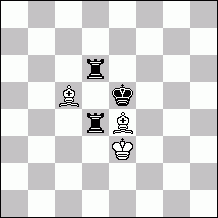
|
|
h8# 3+3
|
h3# 3+3
|
|
Circe White must check
a)b)-Sg3 1.Kf4 h:g3+ 2.Kf5 g4+ 3.Kf6 g5+ 4.Kf7 g6+ 5.Kf8 g7+ 6.Kf7 g8Q+ 7.Kf6 B:d4+ 8.Kf5 Qg4# b) 1.Kg4 h3+ 2.Kg5 h4+ 3.Kg6 h5+ 4.Kg7 h6+ 5.Kg8 h7+ 6.Kg7 B:d4+ 7.Kh6 h8Q+ 8.Kg6 Qh5# Два варианта с эксцельсиором белой пешки "h" заканчиваются сказочными эхо-матами. |
ChameleonCirce Madrasi
a)b)Bc5→g5 1.Rc6 Bd5 2.R:c5 [+wRa1] Ra6 3.R:d5 [+wRh1] Rh5# b) 1.Rd2 Bg2 2.R:g2 [+wRh1] Rh6 3.R:g5 [+wRa1] Ra5# 1.Rg6 Ke2 2.R:g5 [+wRa1] Ra5+ 3.K:e4 [+wRh1] Rh4# Самопарализация по Madrasi черной ладьи в двух вариантах и выключение в третьем. |
|
S.Shifrin
4th Honourable Mention |
D.Müller
M.Pfannkuche D.Speer Commendation |
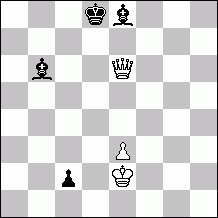
|

|
|
s5# 3+4
|
h3# 3+3
|
|
Maximummer Circe
1.Kd2 Ba4 2.Qe8+ B:e8 [+wQd1] 3.Kc1+ Bd4 4.Qd2 Zzw Ba4 5.e:d4 [+bBf8] Ba3# 1.Q:e8 [+bBc8]+! Kc7 2.Qd8+ Kb8 3.Kf1 Zzw B:e3 [+wPe2] 4.Qc7+ K:c7 [+wQd1] 5.Qe1 Bh3# Два эхо-хамелеонных правильных мата с максимальным использованием возможностей всех белых фигур. |
Circe Rochadeschach
1.K:b7[+wRh1] R:f1[+bSg8] 2.Kc8 Rf7 3.0-0[bKe8/bSd8] Sd6# 1.Kd8 0-0[wKd1/bSc1] 2.Ke8 K:c1[+bSb8] 3.0-0[bKc8/bSd8] Sd6# Двойной Switchback черного короля с эффектом Circe. Задача могла претендовать на более высокое место, если бы в первом варианте присутствовала рокировка белых. |
|
I.Bryuhanov
Commendation |
B.Rothmann
Commendation |
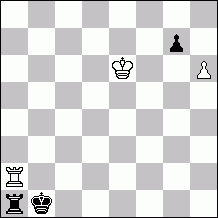
|
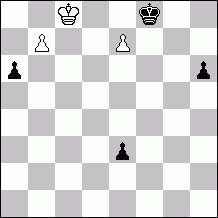
|
|
s7# 3+3
|
14= 3+4
|
|
UltraSchachZwang Circe
1.Kf5! g6+ 2.Kf4 g5+ 3.K:g5 [+bPg7] g:h6 [+wPh2]+ 4.Kg4 h5+ 5.Kg3 h4+ 6.Kg2 h3+ 7.Kh1 K:a2# Систематическое движение белого короля и черной пешки с неожиданным финалом. |
Marscirce Poursuite
1.e8B Ke7 2.Bd7 Ke8 3.Bc6 Kd7 4.B(f1):a6 Kc6 5.b8B Kb7 6.Bc7 Kb8 … 10.Bg3 Kf4 11.Bf2 Kg3 12.Be1 Kf2 13.B(c1):e3 Ke1 14.B(c1):h6= Систематические последовательные движения черного короля и превращенных белых слонов. |
|
S.Shifrin
Commendation |
K.Mlynka
Commendation |
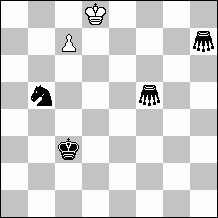
|
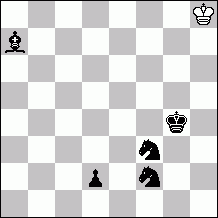
|
|
s7# 2+4
|
sh6# 1+5
|
|
Maximummer Circe
1.Kc8! Gb7 2.K:b7 [+bGb1] Gg6 3.c8Q+ Sc7 4.Qd7 Gc8 5.Q:c7 [+bSb8]+ Sc6 6.Ka6 Gb6 7.Q:b6 [+bGb1] Gb7# 1.c8R+! Sc7 2.R:c7 [+bSb8]+ Sc6+ 3.Kc8 Gb7 4.Rf7 Gg7 5.Kb7 Gb2 6.Ka8 Gf8 7.Rb7 Gb8# Удачно дополняют друг друга горизонтальный и диагональный маты. Особенно красив первый вариант. |
AntiAndernachChess
1.Se1=wB 2.Kf3 3.Ke2 4.Kd1 ReversalEinsteinChess 5.Sd3=wB 6.Bg1=wR Bf2=bR# 1.Kg3 2.Sg4=wB 3.Kf2 4.Ke1 5.Bf2=wR 6.Sh4=wB Rf1=bQ# Тонкая игра черных по построению матового финала для своего короля с эффектными ходами белых в обоих решениях. |
Раздел малюток / Tanagras
|
J.Lörinc
1st-2nd Prize |
D.Novomeský
1st-2nd Prize |
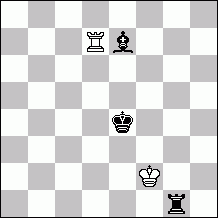
|
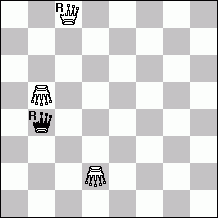
|
|
8# 2+3
|
h8# 3+1
|
|
Koeko Maximummer
1.Ke3? 1…Bd6 2.Kf3 Bh23.Rd3+ Kd4 4.Ke2 Rd1 5.R:d1 Ke3+ 6.Kd3 Kd4 7.Kd2 Be5 8.Ke3# 1…Bd8 2.Kf4 Bg5+ 3.Ke5 Bd8 4.Re7 Kf5 5.Kd6 Rg6+ 6.Re4 Bg5 7.Rg4 Be7+ 8.Ke5# 4…Kd5 5.Re8 Bf6+ 6.Kd6 Rg7 7.Kc5 Rd7 8.Re4# but 1…Kf3! 1.Rd6! 1…Rg3 2.Rf6 Rg7 3.Kf3 Rg2+ 4.Kg3 Kf5 5.Re6 Bh4+ 6.Kf4+ Kf6 7.Re7 Rg7 8.Kf5# 1…Re1 2.Rd3 Re3 3.R:e3 Kd3 4.Re1 Kd2 5.Rf1 Ke3+ 6.Kf3 Kf4 7.Kf2 Bg5 8.Kg3# 2…Rg1 3.Ke2 Rd1 4.R:d1 Kf3+ 5.Kd2 Ke3+ 6.Kd3 Kd4 7.Kd2 Bc5 8.Kc3# Красивые эхо-маты в ложном следе и решении. Впечатляют и маневры белой ладьи. |
Koeko Maximummer
1.rQa5 rQc4 2.rQb6
rQe2 Royal Queen - c8,b4 3.rQc5 Gf1 4.rQg1 rQh2+ 5.rQe3 rQg2 6.rQe1 Gh3 7.rQh4 Gh2# 1…rQa6 2.rQc5 rQd6+ 3.rQc1 Gd7 4.rQc8 Ge8 5.rQc5+ rQd4 6.rQf8 Gd3 7.rQc5+ rQd7 8.rQf8 Gd8# 1…rQc2 2.rQb1+ rQa2 3.rQb4 Ga5 4.rQb1 rQb2+ 5.rQa2 Gc5 6.rQa6 Gb1 7.rQa3+ rQc2 8.rQa1 Gc1# 1…rQc6 2.rQd6+ rQc4 3.rQa6 rQe2 4.rQa4 Gf1 5.rQc2 rQg2 6.rQd1 Gh2 7.rQf3+ rQg1 8.rQh3 Gh1# Тонкая игра рояль-фигур. Четыре эхо-мата в разных концах доски. |
|
K.Mlynka
3rd Prize |
I.Bryuhanov
4th Prize |
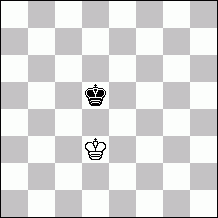
|
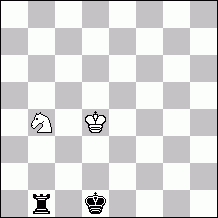
|
|
h3# 1+1
|
s9# 2+2
|
|
BrunnerChess Sentinelles
1.Kc5[+bPd5] Kc3[+wPd3]2.Kb4[+bPc5]+ Kc4[+wPc3] 3.Ka5[+bPb4]+ Kb5[+wPc4]# 1.Kc6[+bPd5] Kd4[+wPd3] 2.Kb5[+bPc6] Kc5[+wPd4] 3.Ka6[+bPb5] Kb6[+wPc5]# 1.Kc4[+bPd5]+ Kd2[+wPd3]+ 2.Kb3[+bPc4] Kc3[+wPd2] 3.Ka4[+bPb3] Kb4[+wPc3]# Хорошо построенная задача на использование сказочных условий с тремя эхо-хамелеонными матами. |
Circe Poursuite
a)b)Kd4→e4 1.Sd5 Tb4+ 2.Ke5 Td4 3.Sf6 Td5+ 4.Ke6 Te5+ 5.Kf7 Te6 6.Sh7 Tf6+ 7.Kg7 Tf7+ 8.Kg8 Tg7+ 9.Kh8 Tg8# b) 1.Sc6 Tb4+ 2.Ke5 Te4+ 3.Kd5 Te5+ 4.Kd6 Td5+ 5.Kc7 Td6 6.Sa7 Tc6+ 7.Kb7 Tc7+ 8.Kb8 Tb7+ 9.Ka8 Tb8# Два эхо-хамелеонных сказочных мата с тонкими маневрами белых фигур. |
|
J.Lörinc
1st Honourable Mention |
J.Štúň
2nd Honourable Mention |
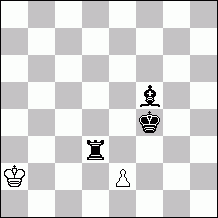
|
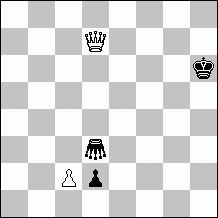
|
|
h10,5= 2+3
|
sh7# 2+3
|
|
Koeko Maximummer
1…e4 2.Rg3
e:f5 3.Ra3 Kb3 4.Ke5 f6 5.Ra4 Kb4 6.Ke6 Kb5 7.Ra6 f7 8.Rd6 Kc6 9.Ke7 f8=R 10.Rf6 Re8+ 11.Kd8 Kc7# 1…e3+ 2.Ke5 e4 3.Ra3 Kb3 4.Kd4 Kc4+ 5.Kc5 e5 6.Rd3+ Kb5 7.Kd6 e6 8.Rd5 e7 9.Bd7 e8=Q 10.Kc7 Qe7 11.Be8 Kb6# Два правильных мата. Эффективное использование сказочных условий в процессе интересных маневров. |
ChameleonChess ParrainCirce
a)b)Qd7→e1 1.d1B 2.B:c2=R 3.Kg6 [+wPb2] 4.R:b2=Q 5.Gh7 [+wPf6] 6.Q:f6=S 7.Kf7 [+wPe7] e8Q# b) 1.Gd1 2.d:e1S 3.Gf1 [+wQg1] 4.Gh1 5.S:c2=B 6.Gh7 [+wPc8=wB] 7.Gb1 Bh3=R# AUW - 4 превращения (S+Q, R+B).Удачное использование ChameleonChess и ParrainCirce в серийной игре. |
|
E.Huber
3rd Honourable Mention |
J.Golha
4th Honourable Mention |
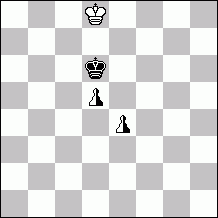
|
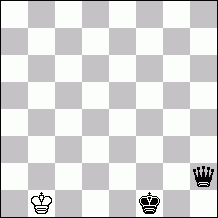
|
|
h4# 1+1+2
|
h4# 1+2
|
|
ParrainCirce Glasgowchess
1.d4 e5+ 2.Kd5 d:e5 3.Ke6 [+nPf6] e:f6 4.K:f6 [+nPg6] g7=nQ [+nPf7=nQ]# 1.Ke5 e:d5 2.Kf6 [+nPe6] d:e6 3.Kg6 [+nPf6] Kc8 4.K:f6 e7=nQ[+nPf7=nQ]# 1.Kc5 e:d5 2.Kb6 [+nPc6] d:c6 3.Ka6 [+nPb6] Ke8 4.K:b6 c7=nQ [+nPb7=nQ]# Три эхо-хамелеонных мата с превращенными ферзями и с интересным использованием синтеза двух сказок. |
EinsteinChess Sentinelles
a)b,c)Kf1→e1,d1 1.Qg2=R[+bPh2] Kc1 2.Rf2=B [+bPg2] Kd2 3.g1 Kd1[+wPd2] 4.Be3=S[+bPf2]+ d:e3=S# b) 1.Qf2=R[+bPh2] Kc1 2.Re2=B [+bPf2] Kc2 3.f1 Kc1[+wPc2] 4.Bd3=S[+bPe2]+ c:d3=S# c) 1.Qe2=R[+bPh2] Ka1 2.Rd2=B[+bPe2] Kb2 3.e1 Kb1[+wPb2] 4.Bc3=S[+bPd2]+ b:c3=S# Три правильных эхо-хамелеонных мата. Удачно сконструированная задача. |
|
G.Bakcsi & L.Zoltan
Commendation |
N.A.Bakke
Commendation |
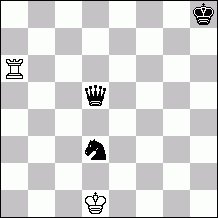
|
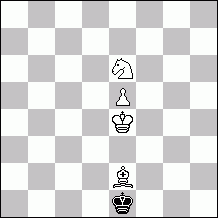
|
|
h7# 2+3
|
sh15# 4+1
|
|
MirrorCirce White must check
1.Kg7 Ra7+ 2.Kf6 Rf7+ 3.Ke5 Rf5+ 4.Kd4 R:d5+ 5.Kc3 R:d3+ [+bSb1] 6.Kb2 Rd2+ 7.Ka1 Ra2# Известный матовый финал достигается эффектным систематическим движением. |
Circe Rochadeschach
1.Kd2 2.Kc3 3.Kb4 4.Ka5 5.Kb6 6.Kc6 7.Kd7 8.K:e6 [+wSb1] 9.Kf7 10.Kg6 11.Kg5 12.Kh4 13.Kg3 14.Kf2 15.Ke1 0-0 [Kc2/Sd3]# Кругосветное путешествие черного короля с прицелом на сказочный финал. |
|
K.Mlynka
Commendation |
B.Horstmann
Commendation |
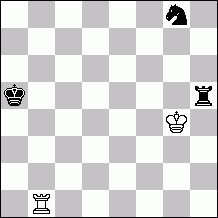
|

|
|
h2# 2+3
|
5= 2+2
|
|
a)
a)AntiAndernachChess ReversalEinsteinChess b) ChameleonChess AntiAndernachChess 1.Se7=wB Ba3=bR 2.Rh3=wQ Qa3=R# 1.Sf6=wB Ba1=bR 2.Rh8=wQ Q:a1=R# b) 1.Rh3=wQ Qa3=bS 2.Se7=wB B:a3=R# 1.Rh8=wQ Qa1=bS 2.Sf6=wB B:a1=R# В форме близнецов выполнено чередование первого и второго ходов белых и черных фигур. Удачная гармония в использовании сказочных условий. |
Maximummer Circe
a)b)mirror a1↔h8 1.Kc6+! Qb6+ 2.R:b6 [+bQd8]+ Q:b6 [+wRa1]+ 3.Kd7 Qg1 4.Kd8 Qa7 5.R:a7= b) 1.Rg1! Qh2 2.Ra1+ Qa2 3.Kd8 Qa6 4.R:a6+ Kb8 5.Ra7= Одна и та же патовая картина получается разными путями. |
M.Grushko
25 февраля 2006 г.
г.Кирьят-Бялик